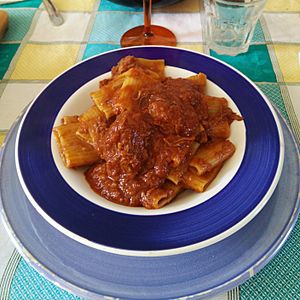Neapolitan ragù facts for kids

Neapolitan ragù served with paccheri
|
|
| Type | Ragù |
|---|---|
| Place of origin | Italy |
| Region or state | Naples |
| Main ingredients | onion, meat, tomato sauce, red wine, basil, lard or olive oil |
Neapolitan ragù is a famous meat sauce from Naples, a city in Italy. In the local Neapolitan language, it's called ’o rraù. In Italian, people call it ragù alla napoletana or ragù napoletano. It's one of the two most well-known types of meat sauces called ragù. The other famous type comes from Bologna and is known as ragù bolognese'.
Contents
What is Neapolitan Ragù?
Neapolitan ragù is a rich sauce made mainly from meat and tomato sauce. A few special seasonings are added to give it a unique taste. This sauce is very different from Bolognese ragù, especially in how the meat is used and how much tomato is in it.
How is the Meat Used?
In Bolognese ragù, the meat is chopped very finely. But for Neapolitan ragù, whole pieces of meat are used. These larger pieces of meat are cooked slowly in the sauce. Once the sauce is ready, the meat is often taken out of the casserole (the cooking pot). It can then be served as a separate main dish, or with pasta.
Key Ingredients and Flavors
The ingredients used in Neapolitan ragù also make it special.
- Instead of white wine, red wine is used.
- Butter is replaced by lard or olive oil.
- Many fresh basil leaves are added, which is different from Bolognese ragù that usually has no herbs.
- Sometimes, extra ingredients like raisins, pine nuts, and involtini (small meat rolls with different fillings) are added to make the sauce even richer.
- Unlike some other ragùs, Neapolitan ragù does not use milk or cream.
- It uses a lot more tomato sauce compared to Bolognese ragù. This is because Naples, being further south in Italy, has a longer tomato growing season.
Types of Neapolitan Ragù
Just like Bolognese ragù, Neapolitan ragù has many different versions. One of the most famous variations is called ragù guardaporta, which means "doorman's ragù." Each family or cook might have their own special way of making it!
Neapolitan Ragù in America
Neapolitan ragù is very similar to a sauce called "Sunday gravy" that is popular in Italian-American cooking. In fact, Neapolitan ragù is like the ancestor of Sunday gravy. The main difference is that the American version often adds a wider variety of meats. These can include famous items like meatballs (which led to spaghetti and meatballs), braciole (thin slices of meat rolled up), sausage, and pork chops.
See also
 In Spanish: Ragù napoletano para niños
In Spanish: Ragù napoletano para niños

